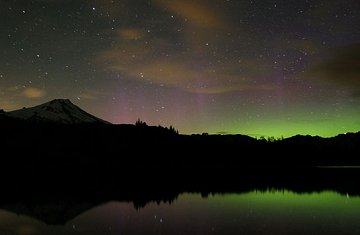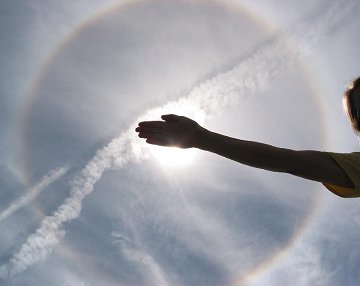 Would you like a call the next time a geomagnetic storm erupts? Sign up for Spaceweather PHONE.
Would you like a call the next time a geomagnetic storm erupts? Sign up for Spaceweather PHONE.
METHANE RAIN: Right now, it's raining on Saturn's moon Titan. That's the conclusion of a group of scientists who have been studying data gathered by the Huygens probe, which landed in the mud on Titan's surface last year. Titanian clouds, they say, produce a steady, year-round drizzle of methane rain. Imagine the rainbows!
COLORLESS AURORAS: On July 27th, a solar wind stream hit Earth, sparking auroras as far south as Washington and Wisconsin. "The entire display was colorless to the eye," says photographer Wade B. Clark Jr. "but the camera picked up some nice green and purple rays." Here is a typical 30-second exposure:

Auroras over Baker Lake, WA. July 27, 2006. Photo Credit: Wade B. Clark Jr.
Lesson: When auroras are pale or dim, grab your camera and shoot. A short exposure may reveal the technicolor scene your eyes can't see.
WHAT'S ON TOP? On July 22nd, "my wife kindly blocked out the sun, revealing a beautiful sun halo criss-crossed by contrails," says photographer Charlie Szabototh of Wiarton, Ontario. The question is, what's on top? The halo or the contrails? Look carefully at the image, then scroll down for the answer:

The contrails are on top. See the dark fringes to the left of the contrails? Those are contrail shadows, cast down on the icy cloud layer that makes the sun halo. "I always find contrail shadows counter-intuitive," notes atmospheric optics expert Les Cowley. "Somehow we expect objects we see in the air to be in front of the clouds. These bright contrails, however, are not beneath the clouds; they are above them as their shadows reveal."
more images: from Bruno Nolf of Otegem, Belgium; from Dave Yates of Bishton, South Wales; from Riccardo Di Nasso of Pisa, Italy; from Laurent Laveder of Bretagne, France; from Martin McKenna of Northern Ireland; from Rodrigo Roesch of Zion, Illinois;

